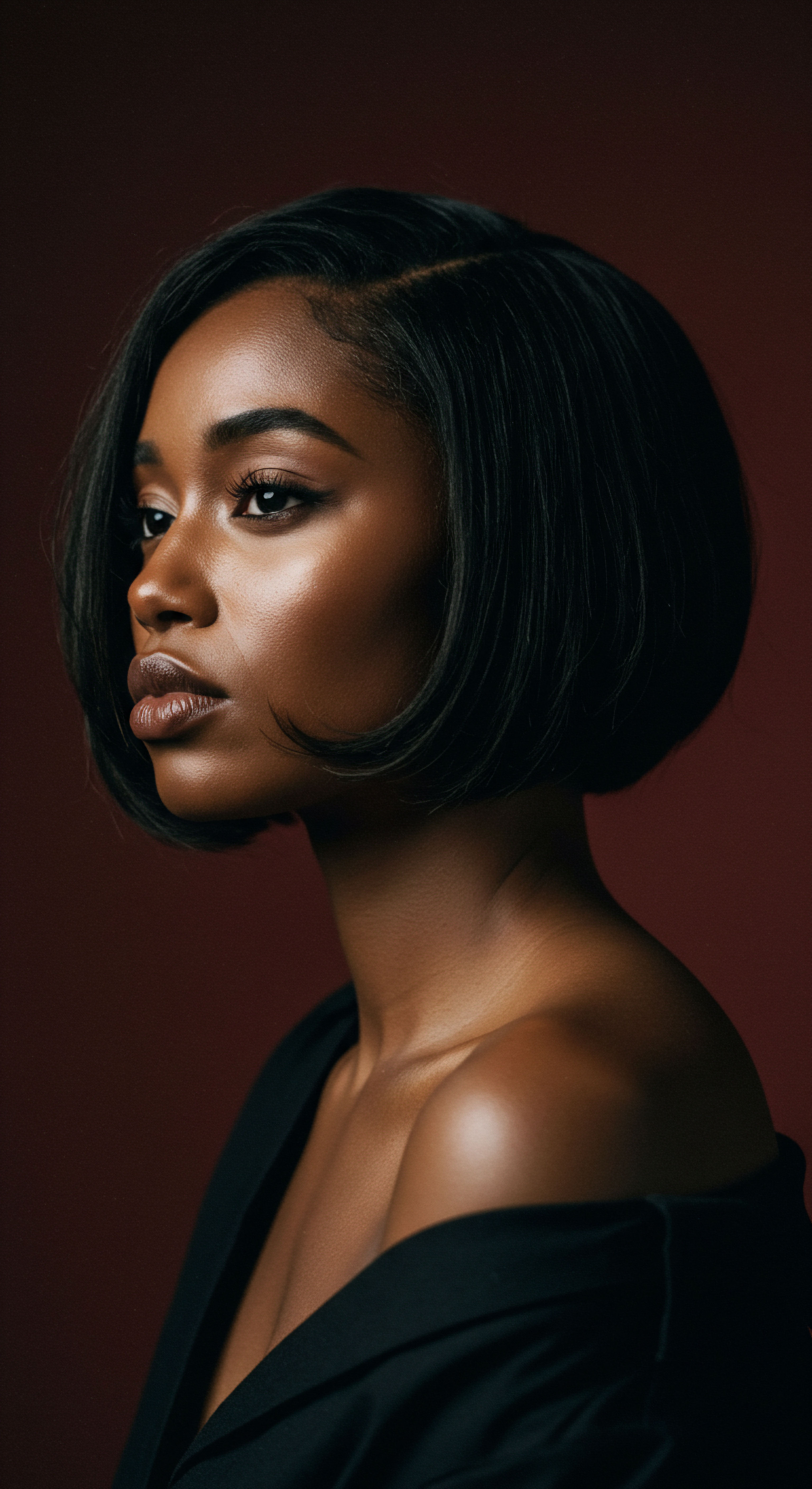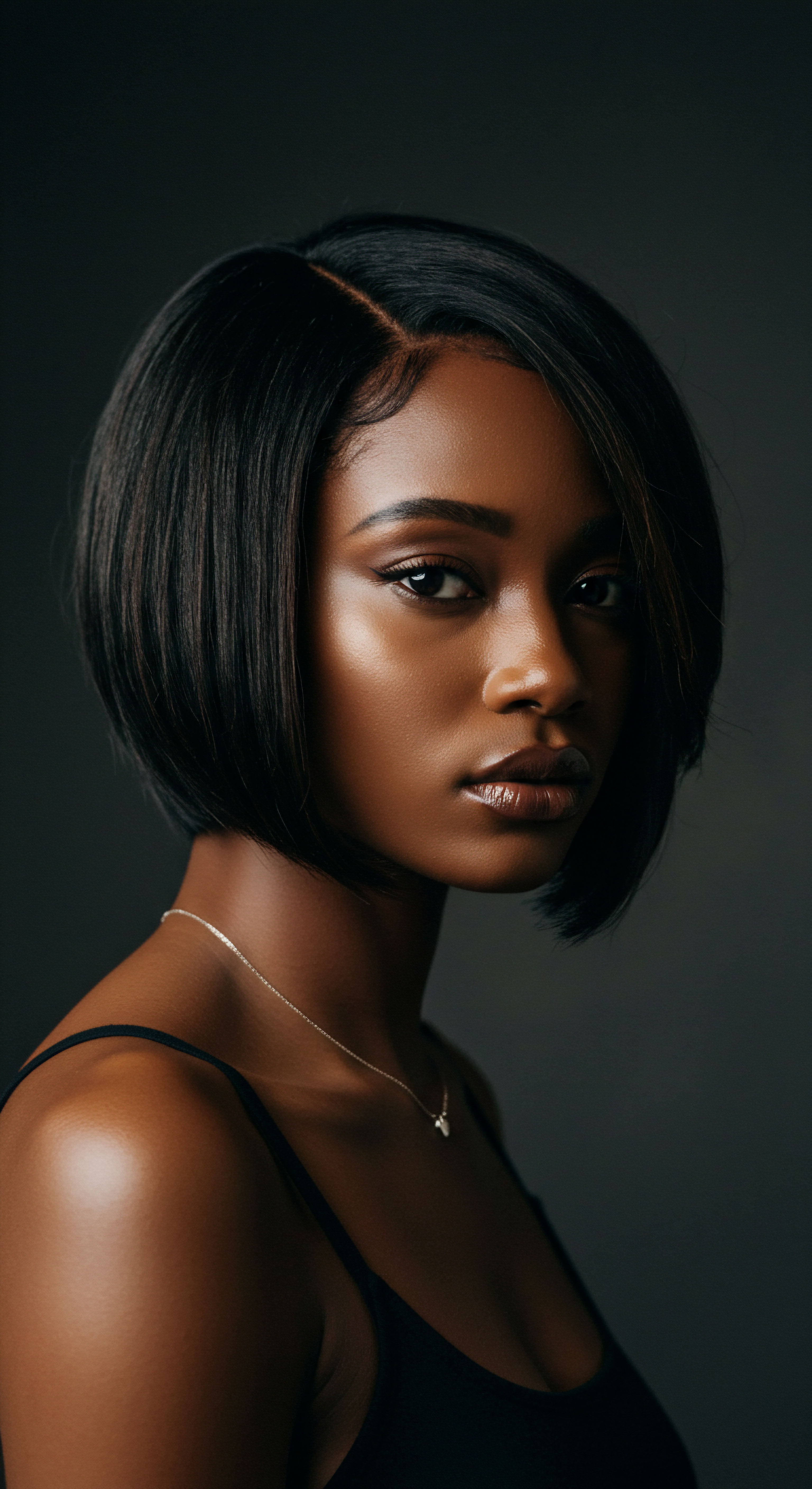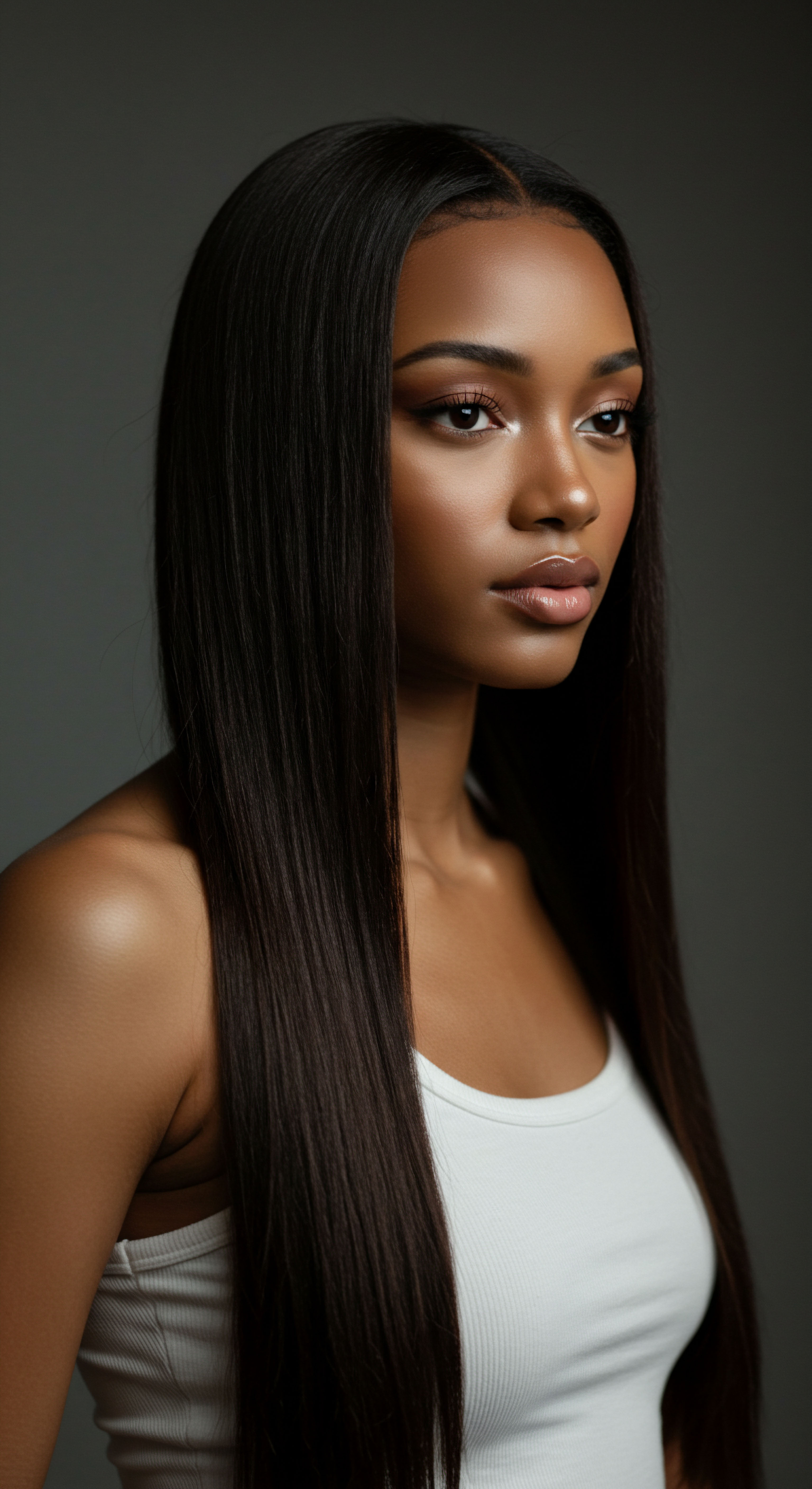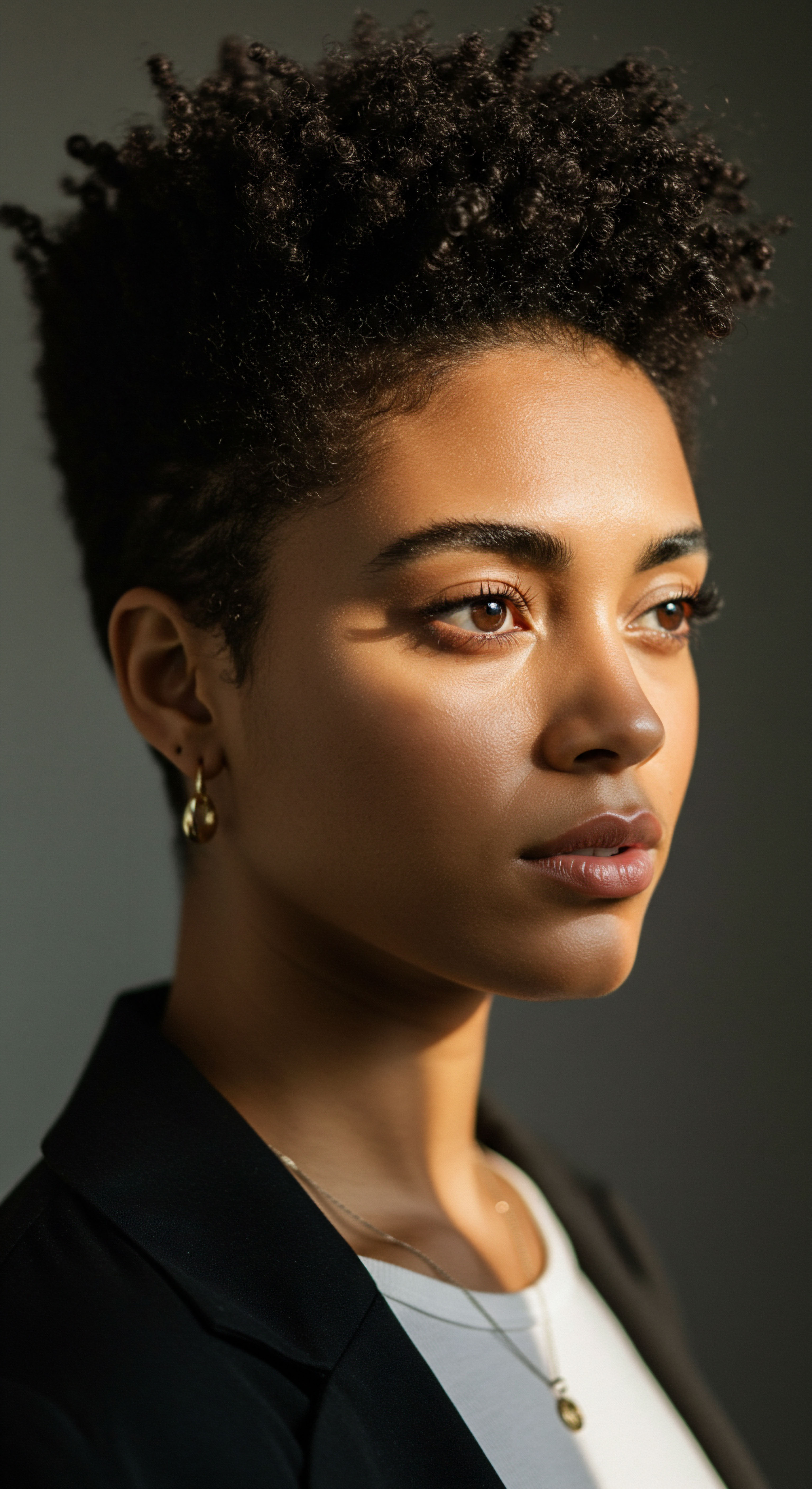
Roots
The gentle whisper of night often brings with it a quiet transformation for our hair, a subtle shift in its very being as we rest. We may not always perceive it, yet the surface upon which our crown settles each evening holds a significant, often overlooked, role in its daily hydration. The material of our pillowcase, that seemingly simple fabric, acts as a silent arbiter of moisture, either a kind keeper of dew or a thirsty thief of vital liquids. Understanding this fundamental interplay begins with appreciating the delicate structure of a single strand, its thirst, and its need for a compassionate resting place.
Hair, particularly textured hair with its beautiful, varied curl patterns, possesses a unique architecture. The outermost layer, the cuticle, is comprised of overlapping scales, much like shingles on a roof. These scales, when healthy and smooth, lie flat, reflecting light and retaining moisture within the hair shaft.
When disturbed, they lift, allowing precious hydration to escape and external elements to penetrate. This foundational understanding is the first step in recognizing why the nightly interaction with our pillowcase holds such weight for hair health.
The nightly interaction between hair and pillowcase significantly influences moisture retention.

What is the Hair’s Natural Hydration System?
Our scalp produces natural oils, known as sebum, which travel down the hair shaft, providing a protective and moisturizing coating. For those with coils, curls, and waves, this journey can be more challenging due to the hair’s helical structure. The natural curves and bends create pathways that impede the smooth descent of sebum, leaving the ends often drier than the roots. This inherent characteristic means textured hair often requires additional support in maintaining its hydration levels.
Beyond sebum, water itself is a primary component of healthy hair. The hair cortex, the main body of the strand, holds water, contributing to its elasticity and strength. When hair lacks sufficient water, it can become brittle, prone to breakage, and appear dull. This makes the nightly preservation of moisture a key objective for anyone seeking vibrant, resilient hair.
- Cuticle Integrity ❉ The outermost layer of hair, formed by overlapping scales, acts as a barrier.
- Sebum Distribution ❉ Natural oils from the scalp provide a protective coating, with challenges for textured hair.
- Water Content ❉ The cortex holds water, impacting elasticity and overall hair health.

How Does Fabric Texture Influence Hair Moisture?
The tactile quality of a pillowcase directly correlates with its potential impact on hair. Fabrics with a rougher surface, composed of short, uneven fibers, create greater friction against the hair strands as we move during sleep. This constant rubbing can cause the delicate cuticle scales to lift and abrade. Once lifted, these scales allow the internal moisture to evaporate more readily into the surrounding air, leading to dryness, frizz, and tangles.
Conversely, materials with a smooth, tightly constructed surface permit hair to glide across them with minimal resistance. This gentle interaction preserves the cuticle layer, keeping it sealed and safeguarding the hair’s hydration. The difference is akin to a gentle slide versus a persistent tug, with profound implications for the hair’s moisture balance.

Ritual
Stepping into the realm of daily hair care, particularly for textured strands, often feels like a mindful practice, a ritual performed with intention. The selection of a pillowcase, far from a mere aesthetic choice, integrates into this nightly ceremony, influencing the very hydration and integrity of our hair as we rest. It is here, in the quiet hours of slumber, that the properties of a fabric can either work in harmony with our hair’s needs or subtly undermine our efforts to keep it moisturized and protected.
Consider the common cotton pillowcase, a ubiquitous presence in many homes. While soft to the touch for skin, its absorbent nature and woven structure can be less forgiving to hair. Cotton fibers, being hydrophilic, readily absorb moisture.
This means that any hydration applied to the hair, or its natural oils, can be drawn away by the fabric throughout the night. For hair already prone to dryness, this constant wicking action can exacerbate moisture loss, leading to increased frizz, tangles, and even breakage.
Choosing the right pillowcase material can transform nighttime hair care from a challenge into a restorative ritual.

Which Materials Offer Optimal Hair Protection?
When seeking to protect hair hydration during sleep, certain materials stand out for their inherent qualities. Silk and satin are frequently championed for their smooth surfaces and less absorbent properties.
- Silk ❉ A natural protein fiber, silk possesses a remarkably smooth surface. This allows hair to glide over it with minimal friction, reducing mechanical stress on the cuticle. Its protein structure also means it is less absorbent than cotton, preserving the hair’s natural oils and applied moisture. This helps maintain the hair’s hydration levels, leading to less dryness and frizz upon waking.
- Satin ❉ Often made from synthetic fibers like polyester, satin replicates the smooth feel of silk through its specific weave. While not a natural fiber, its slick surface offers similar benefits in reducing friction and preventing hair snagging. Satin is also less absorbent than cotton, contributing to better moisture retention for the hair. For those seeking an alternative to silk, satin provides a more accessible option with comparable advantages for hair protection.
The distinction between silk and satin often centers on their origin and precise chemical makeup, but their functional impact on hair, primarily through reduced friction and moisture preservation, aligns. Both create a gentle environment for strands.

How Does Fabric Absorbency Influence Hair Moisture Levels?
The capacity of a fabric to absorb liquids directly correlates with its effect on hair hydration. Highly absorbent materials, such as cotton, act like sponges, drawing moisture from the hair shaft and leaving it vulnerable to dryness. This phenomenon is particularly relevant for textured hair, which naturally struggles with moisture retention.
A study comparing silk pillowcases to cotton pillowcases found that silk was shown to absorb significantly less face cream, suggesting its reduced absorbency extends to hair products and natural oils as well. This characteristic of silk allows the hair to retain its essential hydration, rather than losing it to the pillow.
Conversely, materials with low absorbency, like silk, permit the hair to maintain its inherent moisture balance throughout the night. This difference is not merely about comfort; it is about preserving the hair’s structural integrity and its ability to remain supple and resilient.
| Material Cotton |
| Surface Texture Rough, fibrous |
| Moisture Absorbency High |
| Friction Level High |
| Impact on Hair Hydration Can lead to moisture loss and dryness |
| Material Silk |
| Surface Texture Smooth, slick |
| Moisture Absorbency Low |
| Friction Level Very Low |
| Impact on Hair Hydration Helps retain moisture and natural oils |
| Material Satin |
| Surface Texture Smooth, slick (synthetic) |
| Moisture Absorbency Low |
| Friction Level Low |
| Impact on Hair Hydration Aids in moisture retention, less drying than cotton |
| Material Bamboo |
| Surface Texture Soft, slightly fibrous |
| Moisture Absorbency Moderate |
| Friction Level Moderate |
| Impact on Hair Hydration Better than cotton, but can still cause some friction |
| Material Materials with smoother surfaces and lower absorbency offer superior hydration support for hair. |

Relay
The journey into understanding hair hydration, particularly as influenced by our nightly resting surfaces, leads us to a deeper contemplation of material science, historical practices, and the very mechanics of friction. Beyond the surface-level observations, a complex interplay of factors shapes how our hair retains or loses its vital moisture. This advanced perspective requires us to consider not just what we perceive, but the underlying principles that govern hair health.
For centuries, cultures around the world have intuitively understood the significance of protecting hair during sleep. From African head wraps to Asian silk scarves, these practices, born of necessity and passed down through generations, often predated modern scientific understanding of hair biology. The wisdom embedded in these traditions, now supported by contemporary research, highlights a consistent drive to preserve hair integrity against environmental and mechanical stressors.
Historical hair care practices, often involving protective coverings, offer profound insights into modern hair hydration strategies.

How Does Friction Affect Hair Cuticle Integrity?
The cuticle, the outermost layer of the hair shaft, serves as the primary defense against moisture loss and damage. Its scale-like structure, while robust, is vulnerable to mechanical abrasion. When hair rubs against a rough surface, such as a cotton pillowcase, the constant movement can cause these scales to lift, chip, or even break off. This damage compromises the hair’s protective barrier, allowing water molecules to escape and leading to increased porosity and dryness.
Research in tribology, the science of interacting surfaces in relative motion, offers compelling insights. Studies on human hair fibers demonstrate that friction can indeed cause significant cuticle wear and fiber damage, particularly under sustained compressive loads. Furthermore, investigations using nanoscale friction force microscopy have shown that the friction coefficient of hair can increase with damage, and that modified surface chemistry plays a role in this increased friction.
This scientific backing reinforces the anecdotal evidence that smooth surfaces, like those found in silk or satin, are crucial for minimizing this abrasive action. The smoother the surface, the less resistance encountered by the hair, thus preserving the cuticle’s integrity and, consequently, the hair’s ability to hold onto its hydration.
Consider a study published in the Journal of Cosmetic Dermatology which indicated that the smooth surface of a silk pillowcase can reduce hair friction by up to 43% compared to cotton. This substantial reduction in friction directly translates to less mechanical stress on the hair cuticle, helping to keep it smooth and closed. A closed cuticle is a hydrated cuticle, as it effectively seals in the hair’s natural moisture and any applied conditioning treatments. This quantitative data point underscores the tangible difference material choice makes at a microscopic level, directly impacting hair hydration and overall health.

Can Fabric Moisture Wicking Properties Alter Hair’s Hydration Equilibrium?
Beyond friction, the hygroscopic nature of different fabrics – their tendency to absorb and retain moisture from the air and contacting surfaces – plays a critical role in hair hydration. Cotton, a highly absorbent material, can hold a significant amount of water, up to 30% of its weight. When hair, especially damp hair, rests on a cotton pillowcase, the fabric actively draws moisture from the hair shaft. This can disrupt the hair’s natural hydration equilibrium, leaving it parched and susceptible to environmental stressors.
In contrast, silk, composed primarily of protein fibers, has a lower absorbency rate, typically around 11%. This means silk is less likely to absorb the moisture from your hair, allowing your strands to retain their natural hydration and any beneficial oils or products applied. This characteristic is particularly beneficial for textured hair, which often requires consistent moisture to maintain its curl definition and prevent brittleness. The difference in absorbency is not merely theoretical; it directly influences the water content within the hair fiber overnight, impacting its softness, elasticity, and susceptibility to breakage.

The Science of Surface Tension and Water Transfer
The principles of surface tension and capillary action also factor into how different materials interact with hair hydration. Cotton fibers, with their more irregular surface and porous structure, create a greater surface area for water molecules to adhere to and be wicked away through capillary action. The microscopic irregularities act like tiny channels, pulling moisture from the hair.
Silk, with its long, smooth, and tightly packed protein fibers, presents a far less inviting surface for water transfer. The lower surface tension between silk and the hair’s natural oils, coupled with minimal capillary action, means that moisture is more likely to remain on or within the hair itself. This physical property of silk helps maintain the lipid layer on the hair’s surface, which is crucial for sealing in moisture and protecting against external aggressors.
Understanding these microscopic interactions provides a more complete picture of why the choice of pillowcase material extends beyond comfort to influence the very hydration and health of our hair.

Reflection
The journey through the silent influence of pillowcase materials on hair hydration reveals a story far richer than mere fabric choice. It speaks to the wisdom held within historical practices, the subtle mechanics of friction, and the quiet dance of moisture at a microscopic level. Our hair, a testament to personal expression and heritage, truly benefits from thoughtful consideration, even in the stillness of night. May this understanding empower each individual to approach their nightly hair care with a renewed sense of purpose, recognizing the profound impact of these seemingly small decisions on the vibrancy and health of their strands.

References
- Robbins, C.R. Chemical and Physical Behavior of Human Hair. Springer-Verlag, New York, 2002.
- Swift, J. Alan. Fundamentals of Human Hair Science. Micelle Press, 1997.
- Corbett, John F. Hair Colorants Chemistry & Toxicology. Micelle Press, 1998.
- Laba, Dennis. Rheological Properties of Cosmetics and Toiletries. CRC Press, 1993.
- Schueller, Randy, and Perry Romanowski. Conditioning Agents for Hair and Skin. CRC Press, 1999.
- Draelos, Zoe Diana, and Lauren A. Thaman. Cosmetic Formulation of Skin Care Products. CRC Press, 2005.
- Goddard, E. Desmond, and James V. Gruber. Principles of Polymer Science and Technology in Cosmetics and Personal Care. CRC Press, 1999.
- Sadaie, Megumi, et al. Studies of human hair by friction force microscopy with the hair-model-probe. Colloids and Surfaces B ❉ Biointerfaces, 2006.
- Konno, Shuko, Koji Asanuma, and Yoshimune Nonomura. Friction Dynamics of Straight, Curly, and Wavy Hair. Journal of Oleo Science, 2024.
- Bhushan, B. Wei, G. and Haddad, P. Friction and wear studies of human hair and skin. Wear, 2005.
- Garcia, M.L. Epps, J.A. Yare, R.S. and Hunter, L.D. Normal cuticle-wear patterns in human hair. Journal of the Society of Cosmetic Chemists, 1978.
- LaTorre, C. and Bhushan, B. Investigation of scale effects and directionality dependence on friction and adhesion of human hair using AFM and macroscale friction test apparatus. Ultramicroscopy, 2006.
- LaTorre, C. and Bhushan, B. Nanotribological characterization of human hair and skin using atomic force microscopy. Ultramicroscopy, 2005.
- Yamada, T. et al. Study on the moisturizing ability of sericin in cosmetics. Journal of the Society of Cosmetic Chemists of Japan, 2001.
- Yoshioka, A. et al. UV protection effect of sericin. Journal of the Society of Cosmetic Chemists of Japan, 2001.